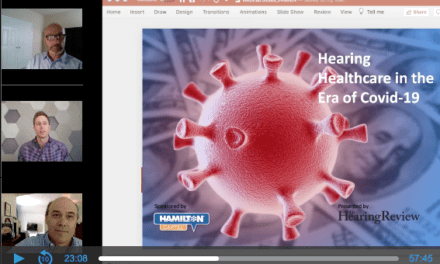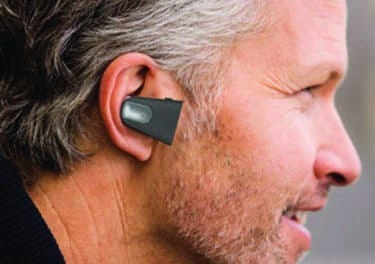How do we account for patient acclimatization in prescriptive fittings? Some fitting philosophies compromise initial gain and/or other parameters in an attempt to provide improved patient comfort and a greater chance for hearing aid acceptance, then gradually adjust the device over a period of time until the prescriptive fitting is achieved. This article discusses fitting considerations related to the rationale used in the new Unitron Automatic Adaptation Manager (AAM).
Clinicians face a continual struggle to configure hearing aid gain/output so that adult clients will accept and use amplification while also benefiting from the professional’s ultimate goal of maximized audibility. Even with advances in modern hearing aid technology, which address many of the shortcomings of past-generation devices, many users still reject amplification.
There are numerous reasons for this. However, for many users, the level of amplified signals exceeds those preferred by the client in their real-world environments—leading to poor first-fit acceptance. In response to this issue, hearing aid manufacturers provide mechanisms to reduce the amount of amplification provided so that it is below the fitting target at the initial fitting.
Should We Be Adjusting Initial Gain Based on User Experience?
When attempting to address rejection concerns, clinicians question which levels of amplification are appropriate to offer to their adult clients. For some clinicians, providing a complete match to fitting formula targets is the gold standard, with the prescribed gain levels indicating the optimal hearing instrument settings. Should there be concerns with the amount of amplification, this fitting approach may include the advice that the client continue to wear the devices as they will “get used to what they are hearing”—a method advocated by many clinicians.1 Regardless of one’s opinion on the accuracy of this philosophy, if the user outright refuses to wear amplification due to a higher-than-preferred initial gain level, there will be no opportunity for an adjustment in gain preference to occur. The provision of a user control (eg, volume adjustment) may address amplification level concerns; however, with the proliferation of automatic devices, manual controls are not always provided. There are also many clients for whom a volume control may not be desired, either due to their inability to use the control appropriately based on cognitive or dexterity issues or due to the patient’s preference to simplify their interaction with the device (ie, they desire automatic function).
The concept of having a client “get used to it” suggests that experience with amplification will alter an individual’s auditory system. Anecdotally, many clinicians live by this fitting approach, whereby they will manipulate gain settings gradually over time based on a belief that a wearer’s preferred amplification experience will change as they acquire experience with the hearing instruments.2,3 Unfortunately, this approach can be haphazard; the starting point and time frame of programming changes are left to a clinician’s intuition and/or the scheduling availability of the clinician and client.
There is some debate in the literature regarding the validity of claims regarding the impact of experience on gain preference over time. For example, a literature review by Convery et al3 found little support for the concept after looking at a number of previous studies in this area.4,5 While any difference trends that were present suggested new users preferred less gain than experienced users, the average difference was no greater than 2 dB and statistically insignificant.
In contrast, other studies have presented data that support the concept that new users prefer significantly less gain than experienced users.6,7 In fact, these findings have led the developers of the recently introduced NAL-NL2 fitting formula to consider amplification experience as a variable in their gain prescription.8
Regardless of the fitting approach adhered to when addressing gain preference concerns, there are data to support the concept that changes in the auditory system occur as a result of experience with amplification. This phenomenon of auditory acclimatization has been studied repeatedly since the late 1980s when Gatehouse9 showed that unilaterally fitted hearing instrument wearers with symmetrical hearing loss performed better in unaided word recognition tasks with their aided ear than with their unaided ear. As Keidser et al7 indicate, while the findings in this area have been inconsistent (presumably due to procedural variations across studies), recent investigations support the concept of acclimatization—at least to high-level, high-frequency sounds—after fitting with hearing instruments.
Adaptation Managers as One Method for Ensuring Acceptance

Figure 1. Automatic Adaptation Manager (AAM) fitting software interface. Fitters can configure the adaptation rate (speed of automatic adjustment; eg, 3 weeks per 5%), current AAM percentage level (eg, 60% of full target), and end AAM percentage level relative to full target (eg, 100% = match prescribed target). If desired, the AAM feature can also be deactivated to revert to a manual adjustment approach.
In response to the viewpoint that hearing instrument experience can impact preferred gain levels, various manufacturers have introduced adaptation manager tools in their fitting software. These tools provide a more structured method for clinicians to gradually introduce increasing levels of amplification to the client relative to an end target.10 The general philosophy of these adaptation management systems is to guide the selection of settings for the clinician from an initial goal of ensuring first-fit acceptance to the ultimate goal of maximizing audibility.
The hearing instrument parameters adjusted by different implementations can vary and may include:
- Gain modification (percentage-based or constant reduction relative to full target prescription);
- Compression modification (varied amount of gain reduction by input level);
- Bandwidth modification (frequency response adjustment); and
- Attack-time modification.10
In some cases, these adaptation manager approaches are static, requiring the clinician to reconnect devices to software and systematically increase the client’s gain settings manually at a number of follow-up visits. Understandably, this manual approach to adjusting hearing aid output may not be convenient or even possible given scheduling availability on the part of the client and/or clinician.
In other cases, some manufacturers have moved toward providing automatic adaptation managers, which gradually adjust the output of the device over a series of weeks/months from a starting point deemed appropriate for initial spontaneous acceptance to a final setting designed to provide optimal audibility. With this automatic approach, the clinician can ensure that the amplification levels experienced by the client are gradually increased over a period of time without the need for follow-up visits.

Depending on the implementation offered, this automatic approach can offer the clinician flexibility to specify the beginning level of amplification, the speed of adaptation, and the desired end level of amplification.
Additional Considerations Beyond Amplification Experience
When developing an adaptation management approach for moving a hearing instrument user from one set of hearing instrument settings (and resulting sound experience) to another gradually over a period of time, there are other factors to consider beyond the previously mentioned variable of amplification experience.
Age considerations. Client age has been shown to impact preferred listening levels (eg, Scollie et al11) and thus could play a valuable role in developing an adaptation management approach. Similarly, research suggests there are age-related changes in the brain’s plasticity such that the capacity to change decreases with age.12 In fact, age has now become an important consideration in the gain prescription calculation used by both DSL v511 and NAL-NL2.8
When considering age in an adaptation manager approach, we should be clear that the inclusion of this variable does not necessarily mean that an adaptation manager philosophy is appropriate for all age groups. In the traditional sense, adaptation management was developed to help graduate adult clients from a point of acceptance (ie, the hearing aid would be worn) to an auditory experience where audibility is optimized.
However, in pediatric fittings, the primary emphasis of the fitting goal is altered. That is, with pediatric clients, the primary fitting goal is to maximize speech intelligibility so that speech and language skills can be acquired appropriately. By fitting below the prescribed targets of validated fitting formulas (eg, DSL v5, NAL-NL1), a pediatric client could be delayed in accessing required auditory information. In pediatric cases, the hearing aid fitting should be biased toward optimizing audibility, with the knowledge that research from the DSL and NAL fitting formula developers has determined that the prescribed amplification targets are also typically preferred in terms of loudness and comfort by pediatric patients.13,14
Other acclimatization factors. Beyond the client-specific variables described above, there is also data to suggest that hearing loss may be an important determiner of an individual’s gain adaptation over time. In this regard, Keidser et al7 found that, relative to experienced hearing instrument users, new hearing instrument users preferred progressively less overall gain than prescribed as hearing loss became more severe. This led the researchers to recommend gain adaptation management for new hearing instrument users with more than a mild hearing loss. It is speculated that new users with more severe hearing losses experience a larger change in audibility than those with milder hearing losses; it may also be that new users with more severe losses cope with their hearing impairment for longer periods of time given the typical progressive nature of hearing impairment.8,15
Melding Knowledge & Technology for Better Adaptation Management
With these client-specific considerations in mind, Unitron has developed an Automatic Adaptation Manager (AAM) designed to increase the probability of spontaneous first-fit acceptance and subsequent use of amplification, while ultimately providing adult clients with a fitting that represents the final desired sound processing.
The AAM, which uses a custom algorithm developed at Unitron, proposes a starting gain level that is a percentage of full target and is based on: 1) Previous experience with amplification; 2) Age; and 3) Hearing loss. The underlying model used to establish the starting adaptation manager setting was based on preferred listening level data collected with new and experienced adult hearing instrument wearers across a range of hearing losses.
The AAM algorithm was designed to be used with adult fittings. Given the aforementioned philosophy regarding the use of AAM in pediatric fittings, the algorithm prescribes a setting of 100% target with ths population.
To address the previously mentioned deficiencies of a “static” adaptation management approach, an automatic component is included that gradually adjusts the gain levels and resulting frequency response/compression of the hearing instrument over a prescribed time frame to the desired end fitting level.
The adaptation rate of 6 months (ie, time to progress from “initial” AM setting to “final” AM setting) prescribed by the system was designed to be conservative and considered the lack of consistency in the literature regarding acclimatization/gain adaptation rates along with clinician opinions regarding the time frame required for full acclimatization to occur (eg, Taylor1 reported on a clinician poll where 85% of respondents selected a time frame no greater than 90 days; Keidser et al7 reported gain adaptation not complete at 13 months post fitting; Palmer et al15 reported auditory learning following deprivation continues up to approximately 18 weeks after fitting).
Given the current lack of clear consensus regarding the time frame over which gain adaptation is complete, the clinician is provided with the ability to adjust the adaptation rate via the fitting software. In this adaptation-rate calculation, the system considers the average client usage rate to be 10 hours per day—an assumption that was subsequently confirmed during real-world trials with hearing-impaired subjects.
Beyond the adjustability of adaptation rate, clinicians are also provided with the flexibility to configure the starting and end positions of the AAM, should they desire to deviate from the prescribed values (Figure 1). The gain levels and resulting frequency response/compression of the hearing instrument are modified as the AAM position setting is automatically adjusted upward toward the desired end value. As shown in Figure 2, this gain adjustment is relatively greater for softer inputs, although an effect can be observed across all input levels.
Initial findings with Unitron’s AAM implementation have been promising. Studies are currently being conducted with independent third-party centers to further investigate Unitron’s AAM implementation and confirm our internal findings.
Conclusion
The fitting of amplification is a challenging process, particularly with individuals who have never worn hearing instruments. Finding the proper balance between settings that are initially acceptable to the wearer, such that they will use hearing instruments, and settings that will ultimately maximize audibility and potential benefit is easier said than done. To address this issue, a number of hearing instrument manufacturers have developed adaptation managers, which progressively move the user from a previous sound experience to another slowly over time.
While the phenomenon of acclimatization and adaptation to amplification remains a controversial subject, recent evidence has led to renewed consideration of this topic on the part of manufacturers and fitting formula developers. The use of an adaptation manager that automatically adjusts hearing instrument settings from those designed to provide spontaneous first-fit acceptance toward those that offer increased levels of audibility can assist clinicians in the fitting process and potentially result in increased satisfaction with certain clients.
References
- Taylor B. Changes in hearing aid benefit over time: an evidence-based review. Available at: www.audiologyonline.com/articles/pf_article_detail.asp?article_id=1853. Accessed January 12, 2012.
- Mueller HG, Powers T. Consideration of auditory acclimatization in the prescriptive fitting of hearing aids. Semin Hear. 2001;22(2): 103-124.
- Convery E, Keidser G, Dillon H. A review and analysis: does amplification experience have an effect on preferred gain over time? Austr NZ J Audiol. 2005;27(1):18-32.
- Cox R, Alexander G. Maturation of hearing aid benefit: objective and subjective measurements. Ear Hear. 1992;13(3):131-141.
- Horwitz A, Turner C. The time course of hearing aid benefit. Ear Hear. 1987;18(1):1-11.
- Marriage J, Moore BC, Alcantara J. Comparison of three procedures for initial fitting of compression hearing aids. III. Inexperienced versus experienced users. Int J Audiol. 2004;43:198-210.
- Keidser G, O’Brien A, Carter L, McLelland M, Yeend I. Variation in preferred gain with experience for hearing-aid users. Intl J Audiol. 2008;47:621-635.
- Dillon H, Keidser G, Ching T, Flax M, Brewer S. The NAL-NL2 Prescription Procedure. Phonak Focus 40. Available at: www.phonakpro.com/content/dam/phonak/b2b/C_M_tools/Library/focus/en/Focus_40_NAL-NL2_Prescription_GB.pdf. Accessed January 12, 2012.
- Gatehouse S. Apparent auditory deprivation effects of late onset: the role of presentation level. J Acoust Soc Am. 1989;86:2103-2106.
- Schum D. Adaptation management for amplification. Semin Hear. 2001;22(2):173-182.
- Scollie S, Seewald R, Cornelisse L, Moodie S, Bagatto M, Laurnagaray D, Beaulac S, Pumford J. The Desired Sensation Level multistage input/output algorithm. Trends Amplif. 2005;9(4):159-197.
- Tremblay K, Kraus N. Beyond the ear: central auditory plasticity. Otorinolaringologia. 2002;52:93-100.
- Ching T, Newall P, Wigney D. Comparison of severely and profoundly hearing impaired children’s amplification preferences with the NAL-RP and the DSL 3.0 prescriptions. Scand Audiol. 1997;26:219-222.
- Scollie S, Seewald R, Moodie K, Dekok K. Preferred listening levels of children who use hearing aids: comparison to prescriptive targets. J Am Acad Audiol. 2000;11:230-238.
- Palmer C, Nelson C, Lindley G. The functionally and physiologically plastic adjust auditory system. J Acoust Soc Am. 1998;103:1705-1721.
Citation for this article:
Pumford J., Hayes D., Cornelisse L. Automatic Adaptation Management: Addressing First-fit Amplification Considerations Hearing Review. 2012;19(03):34-37.








